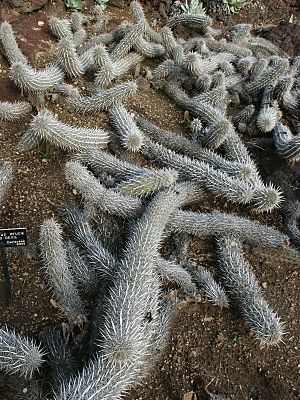Creeping devil facts for kids
Quick facts for kids Creeping devil |
|
|---|---|
 |
|
| Scientific classification | |
| Synonyms | |
|
Cereus eruca |
The Stenocereus eruca, often called the creeping devil, is a very special type of cactus. It's one of the most unique cacti in the world! This plant is found only in a specific area: the central Pacific coast of Baja California Sur in Mexico. It loves sandy soils and often grows in huge groups.
Like all cacti, the creeping devil stores water in its stems. Its stems are spiny and creamy green. They are usually about 5 centimeters (2 inches) thick and can grow up to 1.5 to 2 meters (5-6.5 feet) long. Only the very tip of the stem stands up from the ground. Most of the plant lies flat, reaching a height of only 20-30 centimeters (8-12 inches).
Contents
How the Creeping Devil "Walks"
This cactus gets its name, "creeping devil" or eruca (which means "caterpillar"), because of how it moves. It grows at one end while the other end slowly dies. As it grows, new roots form on the underside of the stem. Over many years, the whole cactus slowly travels across the ground. It's like a living chain, with new parts growing and rooting, while older parts break down. This unique way of growing makes it seem like the cactus is "walking"!
Growth Speed
The creeping devil grows quite fast in its natural home. It can grow more than 60 centimeters (2 feet) each year. But if you try to move it to a hot, dry place, it grows much slower. In those conditions, it might only grow 60 centimeters in ten years! This shows how much it loves its moderate, moist ocean environment.
Flowers and Fruit
The creeping devil cactus has large, beautiful flowers. They open at night and can be white, pink, or yellow. These flowers are usually 10-14 centimeters (4-5.5 inches) long. They don't bloom very often, usually only after it rains. After the flowers, the cactus produces spiny fruit. The fruit is 3-4 centimeters (1-1.5 inches) long and contains black seeds.
Cloning Itself
The creeping devil is amazing because it can make copies of itself! Scientists call this "clonal propagation." This means the plant can clone itself without needing seeds or other plants. Pieces of the main stem can break off as the older parts die. These detached pieces can then grow into new, separate plants. This is very helpful for the cactus because there aren't many animals to help pollinate its flowers in its isolated home.
Other Cacti in the Area
Other types of Stenocereus cacti live in the Baja Peninsula of California too. These include the Stenocereus thurberi, also known as the Organ Pipe Cactus, and the Stenocereus gummosus, or Sour Pitaya.
At one time, people thought the creeping devil cactus might be in danger of disappearing. But later, more studies showed that it was not threatened. Even though it's possible to move these cacti, it's not a good idea. They need very specific conditions to grow well, so it's best to leave them in their natural home.
See also

- In Spanish: Stenocereus eruca para niños

